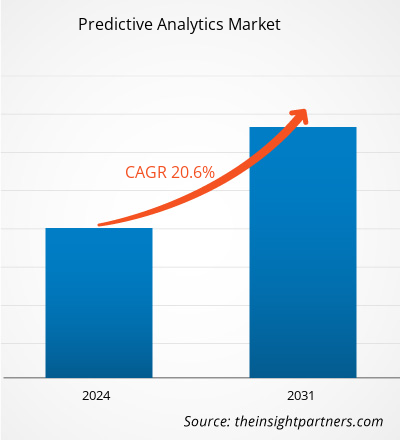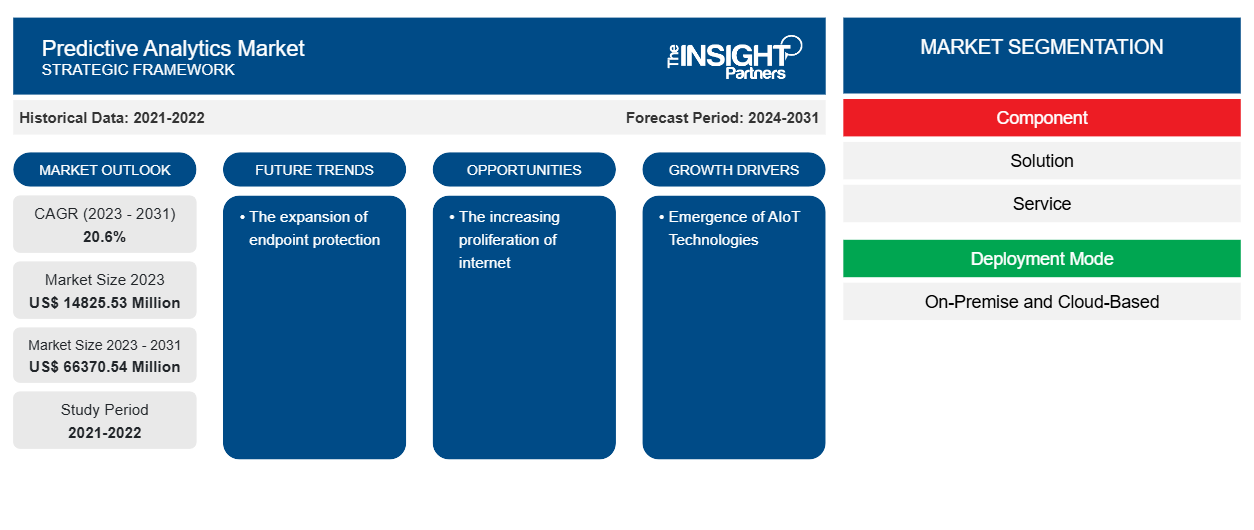予測分析市場規模は、2023年の1億4,825.53百万米ドルから2031年には6億6,370.54百万米ドルに達すると予測されています。市場は2023年から2031年の間に20.6%のCAGRを記録すると予想されています。エンドポイント保護の拡大は、引き続き市場の主要なトレンドとなると思われます。
予測分析市場分析
高度な予測分析ツールが広く採用されるようになり、企業はビッグデータを使用して、可能性や危険を積極的に検出するようになりました。最新のテクノロジーにより、予測分析はこれまで以上に利用しやすくなりました。企業は、売上の向上、プロセスの合理化、顧客満足度の向上など、予測分析を使用する前にビジネス目的を特定する必要があります。その後、適切なツールを使用することで、その組織は予測分析モデルを作成し、実用的な洞察を生み出し、その目的を達成するために膨大な量の異種データをふるいにかけることができます。
予測分析市場の概要
予測分析は、統計モデリング、データ マイニング、機械学習とともに履歴データを使用して将来のイベントを予測する、高度な分析のサブフィールドです。企業は予測分析を使用してこのデータの傾向を調べ、可能性と危険を正確に特定します。予測分析は、データ サイエンスやビッグ データと頻繁に関連付けられています。現在、企業はデータで溢れており、ログ ファイル、写真、ビデオなど、社内のさまざまなデータ リポジトリに保存されています。データ サイエンティストは、機械学習とディープラーニング アルゴリズムを使用してデータの傾向を特定し、将来の発生を予測して貴重な洞察を引き出します。ニューラル ネットワーク、決定木、ロジスティック回帰モデル、線形回帰モデル、その他の統計手法は、これらの一部です。特定のモデリング戦略では、予備的な予測洞察を活用して、より多くの予測洞察を得ます。
要件に合わせてレポートをカスタマイズする
このレポートの一部、国レベルの分析、Excelデータパックなど、あらゆるレポートを無料でカスタマイズできます。また、スタートアップや大学向けのお得なオファーや割引もご利用いただけます。
- このレポートの主要な市場動向を入手してください。この無料サンプルには、市場動向から見積もりや予測に至るまでのデータ分析が含まれます。
予測分析市場の推進要因と機会
AIoTテクノロジーの出現
モノのインターネット (IoT) インフラストラクチャと人工知能 (AI) テクノロジが組み合わさって、モノの人工知能(AIoT) が形成されます。AIoT は、データ管理と分析、人間と機械の相互作用、IoT 運用の効率性の向上を目指しています。人工知能 (AI) は、音声認識、マシン ビジョン、自然言語処理で広く利用されています。AI は、コンピューター、特にコンピューター システムによる人間の知能プロセスのエミュレーションです。モノのインターネット (IoT) は、相互接続されたコンピューティング デバイス、デジタルおよび機械の機械、または人間対人間または人間対コンピューターのインターフェイスなしでネットワーク経由でデータを通信できるアイテムのシステムです。AIoT は革新的で、両方の種類のテクノロジに有利です。AI は機械学習機能を通じて意思決定を改善し、IoT に価値を追加します。
インターネットの普及
インターネットの普及は世界的に拡大しています。そのため、環境トンネルシステムの照明代替品の採用が増え、市場にさらなるチャンスが生まれています。2024年4月初旬、世界中のインターネットユーザーは54億4千万人で、これは世界人口全体の67.1%に相当します。この驚異的な数字は、現在、インターネットユーザー数が非ユーザーの2倍以上であり、インターネットユーザーが「超多数派」になっていることを示しています。インターネットを使用する人の数も増加しており、最新の数字によると、2024年4月までの1年間で、世界中で1億7,800万人以上がインターネットに接続しました。したがって、インターネットの普及が進むにつれて、予測分析市場にさまざまなチャンスが生まれています。
予測分析市場レポートセグメンテーション分析
予測分析市場分析の導出に貢献した主要なセグメントは、コンポーネント、展開モード、組織規模、および業界垂直です。
- 予測分析市場は、コンポーネントに基づいてソリューション(リスク分析、マーケティング分析、販売分析、顧客分析など)とサービスに分かれています。ソリューションセグメントは、2023年に大きな市場シェアを占めました。
- 展開モード別に見ると、市場はオンプレミスとクラウドベースに分かれています。クラウドセグメントは2023年に大きな市場シェアを占めました。
- 組織の規模によって、市場は中小企業 (SME) と大企業に分類されます。
- 業界別に見ると、市場は IT および通信、BFSI、エネルギーおよび公共事業、政府および防衛、小売および電子商取引、製造業、その他に分類されます。
地域別予測分析市場シェア分析
予測分析市場レポートの地理的範囲は、主に北米、アジア太平洋、ヨーロッパ、中東およびアフリカ、南米および中米の 5 つの地域に分かれています。
アジア太平洋地域は予測分析市場を独占しています。この地域の予測分析市場は、インターネットの利用増加や技術の進歩など、さまざまな要因により成長しています。この地域の企業は、在宅勤務モデルに関連するセキュリティの脅威を管理するためにカスタマイズされたインテリジェントな管理ソリューションの特定に、より多くの資金とエネルギーを投資しています。そのため、 予測分析市場は今後数年間で大幅な成長を遂げると予想されています。
予測分析市場の地域別分析
予測期間を通じて予測分析市場に影響を与える地域的な傾向と要因は、Insight Partners のアナリストによって徹底的に説明されています。このセクションでは、北米、ヨーロッパ、アジア太平洋、中東およびアフリカ、南米および中米にわたる予測分析市場のセグメントと地理についても説明します。

- 予測分析市場の地域別データを入手
予測分析市場レポートの範囲
| レポート属性 | 詳細 |
|---|---|
| 2023年の市場規模 | 148億2553万米ドル |
| 2031年までの市場規模 | 663億7054万米ドル |
| 世界のCAGR(2023年~2031年) | 20.6% |
| 履歴データ | 2021-2022 |
| 予測期間 | 2024-2031 |
| 対象セグメント | コンポーネント別
|
| 対象地域と国 | 北米
|
| 市場リーダーと主要企業プロフィール |
|
予測分析市場のプレーヤー密度: ビジネスダイナミクスへの影響を理解する
予測分析市場は、消費者の嗜好の変化、技術の進歩、製品の利点に対する認識の高まりなどの要因により、エンドユーザーの需要が高まり、急速に成長しています。需要が高まるにつれて、企業は提供内容を拡大し、消費者のニーズを満たすために革新を起こし、新たなトレンドを活用し、市場の成長をさらに促進しています。
市場プレーヤー密度とは、特定の市場または業界内で活動している企業または会社の分布を指します。これは、特定の市場スペースに、その市場規模または総市場価値に対してどれだけの競合相手 (市場プレーヤー) が存在するかを示します。
予測分析市場で事業を展開している主要企業は次のとおりです。
- IBMコーポレーション
- マイクロソフト株式会社
- オラクル株式会社
- SAP SE
- グーグル
- SASインスティテュート株式会社
免責事項:上記の企業は、特定の順序でランク付けされていません。

- 予測分析市場のトップキープレーヤーの概要を入手
予測分析市場のニュースと最近の動向
予測分析市場は、主要な企業出版物、協会データ、データベースなど、一次調査と二次調査後の定性的および定量的データを収集することによって評価されます。予測分析市場の動向のいくつかを以下に示します。
- ヘルスケア業界向けの会話型 AI およびデジタル エンゲージメント ソリューションのリーダーである mPulse は、2023 年第 1 四半期と比較して 2024 年第 1 四半期にすべての事業セグメントで成長が見られ、勢いが増すと発表しました。同社はまた、統合予測分析およびオムニチャネル エンゲージメント製品機能のリリースを発表し、デジタル ヘルス エコシステム内に新しいカテゴリを確立しました。(出典: mPulse、プレス リリース、2024 年 5 月)
- イノベーションと持続可能性を推進する産業用ソフトウェアの世界的リーダーであるAVEVAは、石油・ガス、電力、化学、鉱業・鉱物、製造業における産業資産の予測監視に特化した最新のAVEVA Predictive Analyticsソフトウェアリリースのリリースを発表しました。このソフトウェアは、産業事業者が産業資産の信頼性とパフォーマンスを可能な限り最高レベルに高めるとともに、持続可能性を向上させ、従業員の生産性を高めるのに役立ちます。(出典: AVEVA、プレスリリース、2023年2月)
予測分析市場レポートの対象範囲と成果物
「予測分析市場の規模と予測(2021〜2031年)」レポートでは、以下の分野をカバーする市場の詳細な分析を提供しています。
- 予測分析市場の規模と予測(対象範囲に含まれるすべての主要市場セグメントの世界、地域、国レベル)
- 予測分析市場の動向、および推進要因、制約、主要な機会などの市場動向
- 詳細なPEST/ポーターの5つの力とSWOT分析
- 主要な市場動向、世界および地域の枠組み、主要プレーヤー、規制、最近の市場動向を網羅した予測分析市場分析
- 市場集中、ヒートマップ分析、主要プレーヤー、予測分析市場の最近の動向を網羅した業界の状況と競争分析
- 詳細な企業プロフィール
- 過去2年間の分析、基準年、CAGRによる予測(7年間)
- PEST分析とSWOT分析
- 市場規模価値/数量 - 世界、地域、国
- 業界と競争環境
- Excel データセット
最新レポート
お客様の声
購入理由
- 情報に基づいた意思決定
- 市場動向の理解
- 競合分析
- 顧客インサイト
- 市場予測
- リスク軽減
- 戦略計画
- 投資の正当性
- 新興市場の特定
- マーケティング戦略の強化
- 業務効率の向上
- 規制動向への対応





















 無料サンプルを入手 - 予測分析市場
無料サンプルを入手 - 予測分析市場